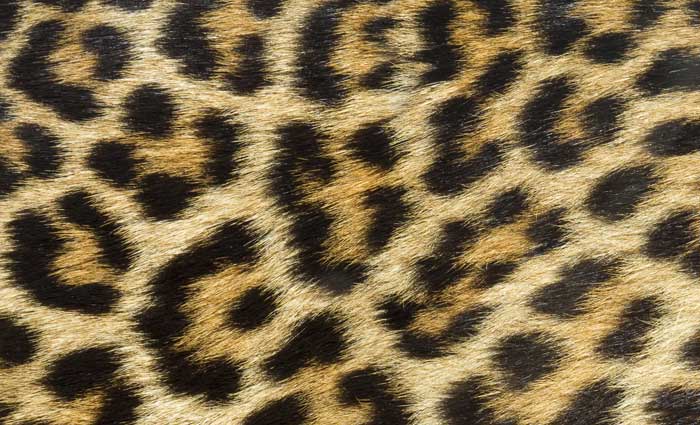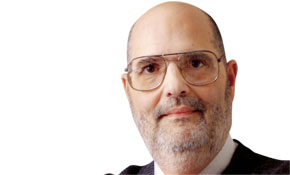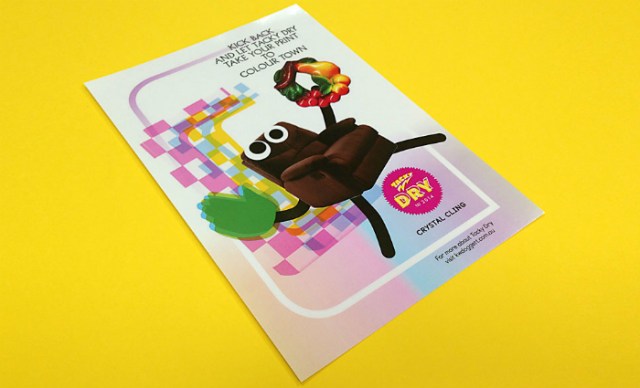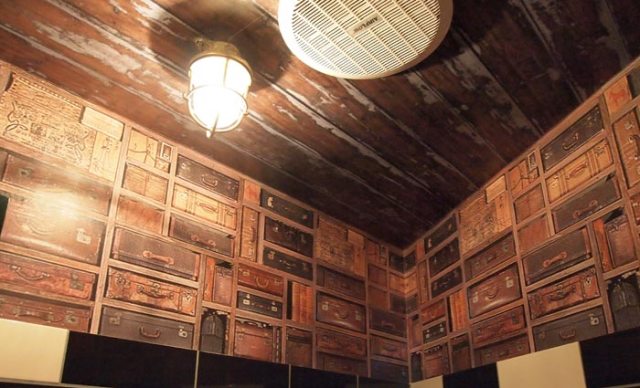
Forget boring vinyls. Materials developments are growing in leaps and bounds. Burgeoning inkjet print technologies might get all the focus, but the substrate is half the job, and the variety of original, creative and revolutionary stocks has grown exponentially. The applications are limited only by the imagination of wide-format print providers and their customers.
Sydney wide-format specialist Look Print is partnering with fellow printers in the US, UK and Europe on a series of wide-format ventures. The company is also collaborating with chemicals manufacturers on custom-made coatings to create solutions such as a waterproof, non-slip coating applied in accordance with Australian safety standards.
Managing director David Leach is excited about the new processes, such as printing on concrete and glass. He says the growth and maturation of UV inkjet, a non-contact technology, creates opportunities to print on textured and uneven surfaces. “There’s enormous capacity in the marketplace. Differentiating is challenging – and sometimes not very profitable at first.”
Maybe not at first, but new ideas mean new markets – and new profits. Innovation can equal dollars, but true innovation is sadly lacking, says Leach. Many printers are playing the new substrates game close to the chest, he tells ProPrint. “There’s a lot of ‘me-tooism’ when it comes to printing on new and different substrates, and printers who are working on these kinds of solutions tend not to want to talk about them.”
An abundance of ideas
Leach laments a lack of originality in the Australian wide-format sector and believes it is up to printers to generate exciting applications for their customers, rather than waiting for customers with ideas.
There are also hazards of trying to be too bleeding edge. Sometimes a hardware vendor will promote new stocks to shift the printing hardware, he cautions, when in reality the solution they describe still needs years of R&D. “We prefer to develop new ideas that are printable on our existing wide-format equipment, and if we have to invest in additional equipment, we try to avoid new gear.”
At PacPrint, there was no shortage of ideas for wide-format concepts outside the box. Plenty of vendors turned their booths into veritable portfolios of what clever materials can do. HP had a mock living room to show off interior decorating opportunities. Rojo Pacific was promoting its Supa Cling re-usable window film, which can be mounted to smooth surfaces, such as glass, and easily repositioned. But surely the most standout demonstration of clever materials was at the DES stand. Visitors were treated to an immersive experience with self-adhesive films and pressure-sensitives from US developer MacTac that pleased the eye and tempted fingers.
The substrates offered textures ranging from wood grain to carbon fibre – and even peach fuzz. Applications ranged from floor graphics to pavement graphics that could be laid over bitumen, and WW wall-wrap range and vehicle graphics. DES sign & display manager Mark McInnes got a kick out of reminding guests to look down at a faux tiled ceramic floor, ideal for durable, short-term decorative and display applications.
According to McInnes, it’s early days in Australia, but he expects the latest crop of substrates currently wowing European customers will have the same impact locally. He is backed by Denise Nathan, New Zealand-based marketing manager of MacTac Oceania, who says the variety of print films and laminates for interior design has never been greater. “What’s cool is that not only do these films look like interior-design substrates, they also feel like the real thing. Wood grain, peach skin, leather, velvet, crystal and brushed aluminium are just some of the amazing finishes you can achieve with these films.”
Light years ahead
MacTac even played a starring role at the recent Vivid Sydney festival in May–June, which transformed the city’s harbour front into a spectacular canvas of light, music and ideas such as light installations and projections. MacTac’s WW100 wall wrap for brick and concrete surfaces was a key part of an installation in the ‘Suez Canal’, an 1800s laneway in the historic Rocks area, she says.
WW100 wrap was chosen for Vivid Sydney to solve an installation problem. “With the walls of the Suez Canal being an historical site, the installation of mirrors to reflect the laser beams had to be applied to the walls without causing damage. WW100 was conformed to the sandstone walls and the mirrors fixed to the film to preserve the integrity of the substrate.”
At Next Printing in Sydney, MacTac has prised open a new POS market. General manager Romeo Sanuri tells ProPrint the MacTac substrates are used with Re-board, a patented recyclable made from post-consumer waste. Next recently used its HP Scitex FB7600 flatbed to print on 10mm and 16mm Re-board laminated with MacTac wood grain and brushed aluminium-look substrates to create display furniture. It was a POS project for Toshiba, promoting its new Kira notebook computer. The finished display, with the printed elements from Next, was a full 3D piece with LED inserts.
The nine-year-old St Peters company, with some 40 staff, became a wide-format and outdoor display specialist in 2004, from its origins as a photographic processor founded in 1986. Sanuri says the eco-board enhances and supplements its retail displays for fashion and electronics, exhibition graphics and large-format fabric printing.
Melbourne display printer Visual Solutions is using its EFI Vutek GS3250LX LED UV-curing printer to create new business opportunities, says managing director Marshall Beaumont. The hybrid flatbed and roll-to-roll printer uses ‘cool curing’ to minimise UV curing times. With no VOCs and greater efficiency with consumables, it creates a greener proposition for Visual Solutions’ clients.
Beaumont says the seven-year-old, 12-staff Moorabbin company is partnering with Melbourne plastics developer UFO Display Solutions to trial a 2mm-gauge substrate printable with the Vutek, then vacuum-formed for mouldings to create products such as counter displays and 3D signage. He is upbeat about the trials at UFO and potential markets for versatile, rugged, moulded display media.
A creative touch
People might know Paperlinx-owned merchant Spicers best for its commercial printing stocks, but it is also a major player in more unusual materials.
Spicers’ range of clever substrates can unlock markets for wide-format printers, and Matthew Manteit, product manager, Sign & Display, gives some examples. Polyester-blend, self-adhesive fabric Phototex sticks to non-porous surfaces, such as walls, windows, doors, columns and poles. A low-tack self-adhesive that is removable, repositionable and reusable, Phototex has been developed for personalised wall coverings in corporate, retail and home environments.
Vanity Board, a printable mirrored acrylic panel, is lighter and cheaper than glass and is shatter-proof. It was developed for shop fit-outs, restaurants and promotions for nightclubs – in fact, anywhere with opportunities for mirrors. Skybond is a printable aluminium composite sheet with an easily removable protective liner on both sides. It can be cut, bent or folded, and suits a range of interior and exterior print and fabrication applications – POS, shop fit-outs, wall cladding and exhibitions. G-Floor Graphic lets printers digitally produce customised flooring or mats.
Manteit says Spicers is particularly excited about X-Board, a versatile, 97% recycled, closed-cell fibre sheet for branded promotional, temporary and event furniture. “X-Board has a high strength-to-weight ratio and freedom in design to create complex shapes and displays, which allows your creativity to run wild. X-Board creates brand theatre, allowing you to showcase your products and letting customers interact with your products in a way that no other media can.”
He says X-Board can be printed direct by UV inkjet or decorative laminates can be applied over the board. Panels can be mitre-cut, folded or curved, shape-cut, canvas or fabric-wrapped, photo-mounted and fastened together with velcro, hot-melt adhesive or magnetic strips, generating an array of sustainable design possibilities.
At Omnigraphics, sales director Nathan Sable talks about a number of bold projects generated on its HP UV equipment. For the past 12 months, the Melbourne grand-format company has been trialling prints on a reflective billboard vinyl that highlights metallic components in the image. He sees its application limited only by cost, estimating a 35–40% premium on the product. Currently, it’s a one-off application, he says, and Omnigraphics is working on it with a single customer.
Keen to push the envelope in printing on unusual substrates, the 12-year-old company is also developing its use of a non-adhesive cling laminate for POS applications. The easy-to-install synthetic film hugs windows and other flat surfaces without glueing or other adhesions.
While smart new substrates have lots of potential, Sable says some classy ideas work with basic, readily available stocks. Adding a Hollywood touch, Omnigraphics has been printing scenic and decorative backdrops on open-weave mesh to create faux views that disguise unattractive fencing or blind-sides of buildings.
Case study: Sanderson
X-Board and some creative ingenuity enabled acclaimed Melbourne wide-format printer Sanderson to turn heads at the Clean Energy Week trade show at Sydney’s Darling Harbour Exhibition Centre last year – with a 60m² stand for Greenbank, a carbon credits trader exhibiting at the event.
Sanderson director Ian Sanderson tells ProPrint the company used X-Board from Spicers to construct and brand-print a plethora of stand accoutrements, including 11 planter boxes, four coffee tables, two bar tables, 14 stools, a coffee cart, signage, a 2.4m-high monolith and two display stands carrying brochures.
All items were printed on the company’s 1.2×2.4m flatbed UV digital press, whose brand Sanderson preferred not to state for commercial reasons. The prints were then cut and processed on a Kongsberg finishing table. “It allowed us to print around corners and engineer every piece to furniture quality.”
The whole lot was flatpacked into two purpose-built cartons made from the same material for trucking from Melbourne to Sydney. “We put the whole thing together without glue, it was tab-and-slot, with a few screws. The gardeners came and filled the planter boxes with yucca plants and we were out of there in two hours.”
Dismantling was also a breeze, recalls Sanderson. “At the end of the exhibition, you’ve got about two-and-a-half hours to get out because there’s another show coming in. On that day, two people packed the whole thing up in around one-and-a-half hours. Meanwhile, some other exhibitors were cutting up their exhibitions with chainsaws and electric saws to get out in time, and in some cases, destroying hundreds of thousands of dollars’ worth of melamine cabinetry.
“While this was all going on, our stuff was flatpacked, and ready for the next exhibition.”
Sanderson has also used X-Board to construct and print POS pieces, including bespoke in-floor shelving systems, wine racks, standees, bookshelves and promotional toys.
X-Board comes in a brown craft or high-res white-clay finish and both are well handled on the company’s press, he says.
Sanderson notes a comeback for board as a preferred substrate in these markets, after the predominance of polypropylene sheets. “It’s evolutionary. We’ve been working mostly with polypropylene for the past 15-20 years. We were using board a lot before that with card-constructed packaging. In more recent times, we’ve turned our attention back towards the boards.”
The Kongsberg table was readily adaptable to X-Board. Sanderson says the only caveats are not to over-engineer the designs, as the table’s high-speed knife is not a diecutter, so it is limited in speed and ability, and overdoing it can lead to knife fatigue and blade breaks. “Over-designing can mean unacceptably low price margins or pricing yourself out of the job.”
The 67-year-old Moorabbin company with five staff offers digital print, screen print and CAD-CAM processing. Screen printing, with its fixed set-up costs, has declined markedly as print runs shrink, says Sanderson. “They’re being replaced by smart ideas in digital UV printing.”
Case study: Rojo Pacific
Melbourne-based material supplier Rojo Pacific has been largely fixated on the environmental side of large-format substrates.
As part of its brand overhaul to become better recognised for sustainability, Rojo has devised a way to separate inks from the PVC of billboard skins, allowing them to be recycled, for instance as new billboards or as plant tags.
Managing director John Wright says: “No one recycles their billboard skins. It has been considered impossible to separate the coating from the fabric without contamination, but we have now found a guy who can do it.” The initiative even caught the eye of Sustainability Victoria, which has been supporting Rojo’s sustainability endeavours, while the supplier has also held discussions with major outdoor companies, Adshel and APN.
The environmental initiative is part of a comprehensive relaunch of Rojo Pacific, which is also looking to establish its reputation as a community-minded business by donating 1% of profits to good causes.
“We will continue to do this kind of work, which is better for the business and the environment,” says Wright.
Comment below to have your say on this story.
If you have a news story or tip-off, get in touch at editorial@sprinter.com.au.
Sign up to the Sprinter newsletter



